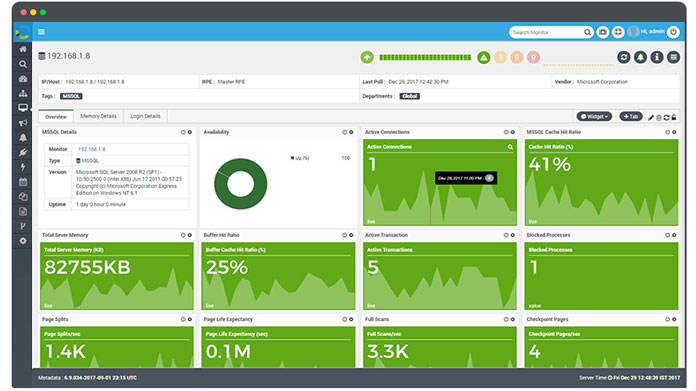Over the past few years, we have seen critical changes in threats we face online and the compliance landscape in the industry. The overall focus on data has increased which was majorly on networks. The management of data risks has turned more complex than merely dropping in a firewall or having simple antivirus software. Our applications and databases run in multifaceted environments with several dependencies and business needs. While we want to guard our information, we require doing it in a way that doesn’t considerably obstruct the important business activities. To stabilize these requirements we see advancements in new-fangled technologies and one of the most essential of which are database monitoring software tools.
Database Performance Monitoring Tools:
Database activity monitoring software tools offer powerful, instant, non-intrusive advantages for managing security and compliance for all-inclusive protection of applications as well as databases. They can be fully utilized to support the facility to spot and report on illegal, fraudulent or any other detrimental behaviour, with minimum impact on user productivity.
These types of tools have advanced from fundamental analysis of user activities to capabilities like vulnerability management, application-level analysis, intrusion avoidance, data security support, access management integration, and risk management sustenance.
This blog compares the strong points as well as the weaknesses of popular database activity monitoring (DAM) software tools. The products mentioned in this blog are all exceedingly rated database performance monitoring tools.
Distinguished Features of Premium Database Activity Monitoring Software Tools
Motadata:
Motadata serves as the unsurpassed database monitoring tool which lets you track, monitor and handle heterogeneous IT infrastructure which comprises of databases such as PostgreSQL, MSSQL, Oracle, IBM DB2 and others. Motadata empowers admins by giving preceding notification before any issue happens. With the use of advanced dashboards and reports, Motadata assists you to meet your SLAs and troubleshoot problems rapidly.
Availability of database servers is decisive to any business. Motadata keeps an eye on database’s performance, availability and monitors all its versions. It generates insights on server sessions, buffer, memory, latches as well as the locks.
It gets you real-time network insights with tailored reports like top applications and conversations by traffic, topmost traffic sources by IP address, best traffic destinations by Host IP, and top traffic receivers by IP.
The exclusive dashboard comes with drag and drop functions to add, edit, modify and delete the required widgets and lets you adapt it as per your needs. You can precisely visualize your infrastructure, completely customize and get a unified view to monitor metrics in one single dashboard.
Motadata supports most 3rd party integrations to make your work simpler. Motadata supports cloud monitoring like AWS along with the integration of monitoring and log collection apps. Motadata listed as best log management software.
Motadata supports distributed deployment and offers high scalability, it can be extended when your infrastructure grows. It enables hosting in-house or in-cloud and also comes with the virtual appliance. The tool comes with 40+ diverse data visualization methods and arithmetic functions that can transform your large data into significant reports.
Hyperic HQ:
Hyperic is a company offering native management and monitors on platforms including Unix, Linux, Windows Solaris, HPUX, AIX, VMware and Amazon Web Services. It works for virtual, physical, and cloud infrastructures. It can handle operating systems, web servers, app servers and database servers.
It comes with built-in support for 75 common elements which covers databases, network devices, middleware, web and application servers. Its precise and methodical discovery feature ferreted out even the microscopic information about the infrastructure, and the tool comes in a simple to understand graphical interface.
Adding together, it provides open source functionalities with scalable systems monitoring and management software accessibility. However, Hyperic falls short of automatic correction of actions; sometimes needs manual efforts to operate and requires running Hyperic HQ’s remediation functionality.
Nagios:
Nagios has an interface that assists users to check the health of the network from anywhere; generates reports on availability, trends, notifications, and alerts through the web interface. It further offers extendable architecture, vibrant community support, proactive planning, multi-tenant capabilities and centralized view of intact monitored IT infrastructure.
However, Nagios web GUI is not of high-quality and a steep learning curve is requisite for handling the config files to operate devices and tests.
ZABBIX:
ZABBIX is a true open source platform that offers proactive monitoring, capacity planning, built-in java application server monitoring, hardware monitoring and virtual machine monitoring. It is from top to bottom configurable from its web front end and so it is simpler to utilize ZABBIX than the Nagios platform whose configuration needs numerous text files.
Additionally, ZABBIX unites both monitoring and trending functions, while Nagios focuses entirely on monitoring. However, ZABBIX is not fit for large networks with more than 1,000 nodes, due to restrictions of performance and web GUI.
Papertrail
Papertrail is a frustration-free log management tool that allows you to instantly manage logs from different servers.
With Papertrail, you can consolidate your logs in one place with a cloud-hosted log management service that takes typically only minutes to set up. Powerful. Quickly diagnose and fix customer problems, error messages, app server errors, and slow DB queries with full visibility across all logs.
Solarwinds:
Solarwinds offers multi-vendor network monitoring with critical path visualization, performance analysis dashboard, smart alerts, wireless heat maps, network Insight for Cisco ASA and F5 BIG-IP as well as wireless management.
It permits users’ environment to be plotted in real-time automatically. This provides graphical visibility into users’ networks, requiring no additional tools. It monitors wireless devices for security and decreases the complexity in managing these items, allowing the more extensive use of wireless technologies.
Spiceworks:
Spiceworks is another network management and monitoring tool with help desk and software reporting solution for managing IT operations in SME’s. It comes with a dynamic dashboard, adjustable alerts, ping check and comes with free support.
It is a good commencing point for IT management but is restricted to outsized networks and provides slow performance levels. It has a limited scalability and fails to offer the similar depth of control as compared to other enterprise products.
The Conclusion:
Motadata is better when compared to the competition, and is thus a much enhanced database performance monitoring tool. Its can enable processing of any type of log data produced from numerous heterogeneous sources. It meets compliance standards which cover PCI DSS, HIPPA, FISMA and more.
It eliminates problems before it turns tough to handle. At the same time, improve your service quality. It monitors and manages all the network devices, servers, and applications transversely with infrastructure deployment.

















